MACRO OCTOBER IN MARLERA - Episode Nine - SUNDAY THE 15TH
hive-173702·@borjan·
0.000 HBDMACRO OCTOBER IN MARLERA - Episode Nine - SUNDAY THE 15TH
Yes, as you probably guessed already, the 15th of October was yet another surprisingly warm October day so I spent a couple of hours in Marlere, busy searching for insects, spiders, and other macro details for this series. <a href="https://files.peakd.com/file/peakd-hive/borjan/Eoc5bMDBZMoE3EvWji4bN8REUEYgYyFcYTNHic3ovJnT4nCRadoqijHwFFKGtezKwkW.jpg"><img src="https://files.peakd.com/file/peakd-hive/borjan/Eoc5bMDBZMoE3EvWji4bN8REUEYgYyFcYTNHic3ovJnT4nCRadoqijHwFFKGtezKwkW.jpg"></a> (Enlargeable) For those who haven't seen any of the previous episodes, Marlera is a coastal area situated a couple of kilometers from the village of Liznjan and about five or six kilometers from where I live. <a href="https://files.peakd.com/file/peakd-hive/borjan/EoeDR1Z6W4izzY9M6azzsDed3LD1RuaaF1yvqRAPbixkRq1arYaYLPsUAoujFC66H7Y.jpg"><img src="https://files.peakd.com/file/peakd-hive/borjan/EoeDR1Z6W4izzY9M6azzsDed3LD1RuaaF1yvqRAPbixkRq1arYaYLPsUAoujFC66H7Y.jpg"></a> (Enlargeable) This is the Carpocoris purpureipennis, a bug from the Pentatomidae family. The insect was resting on the faded flower of the Dittrichia viscosa plant when the photograph was taken. <a href="https://files.peakd.com/file/peakd-hive/borjan/Eo8Kap6BHvrZ9RxgCFMVoyDqQH4eWjuLKyEKWUZkJV3gBWJYxnC1krfCTHSehZNijAF.jpg"><img src="https://files.peakd.com/file/peakd-hive/borjan/Eo8Kap6BHvrZ9RxgCFMVoyDqQH4eWjuLKyEKWUZkJV3gBWJYxnC1krfCTHSehZNijAF.jpg"></a> (Enlargeable) Some of the flowers on the lower part of that same plant were still in good shape. <a href="https://files.peakd.com/file/peakd-hive/borjan/23tbyVxbDnn6uBTLywLWQvpiSp11JMmeRWfGb2w7sAKtEkUs2tXJyCNwVe5rGK9uC9EE3.jpg"><img src="https://files.peakd.com/file/peakd-hive/borjan/23tbyVxbDnn6uBTLywLWQvpiSp11JMmeRWfGb2w7sAKtEkUs2tXJyCNwVe5rGK9uC9EE3.jpg"></a> (Enlargeable) Here you can see a much smaller bug that was feeding on one of those still functional flowers. 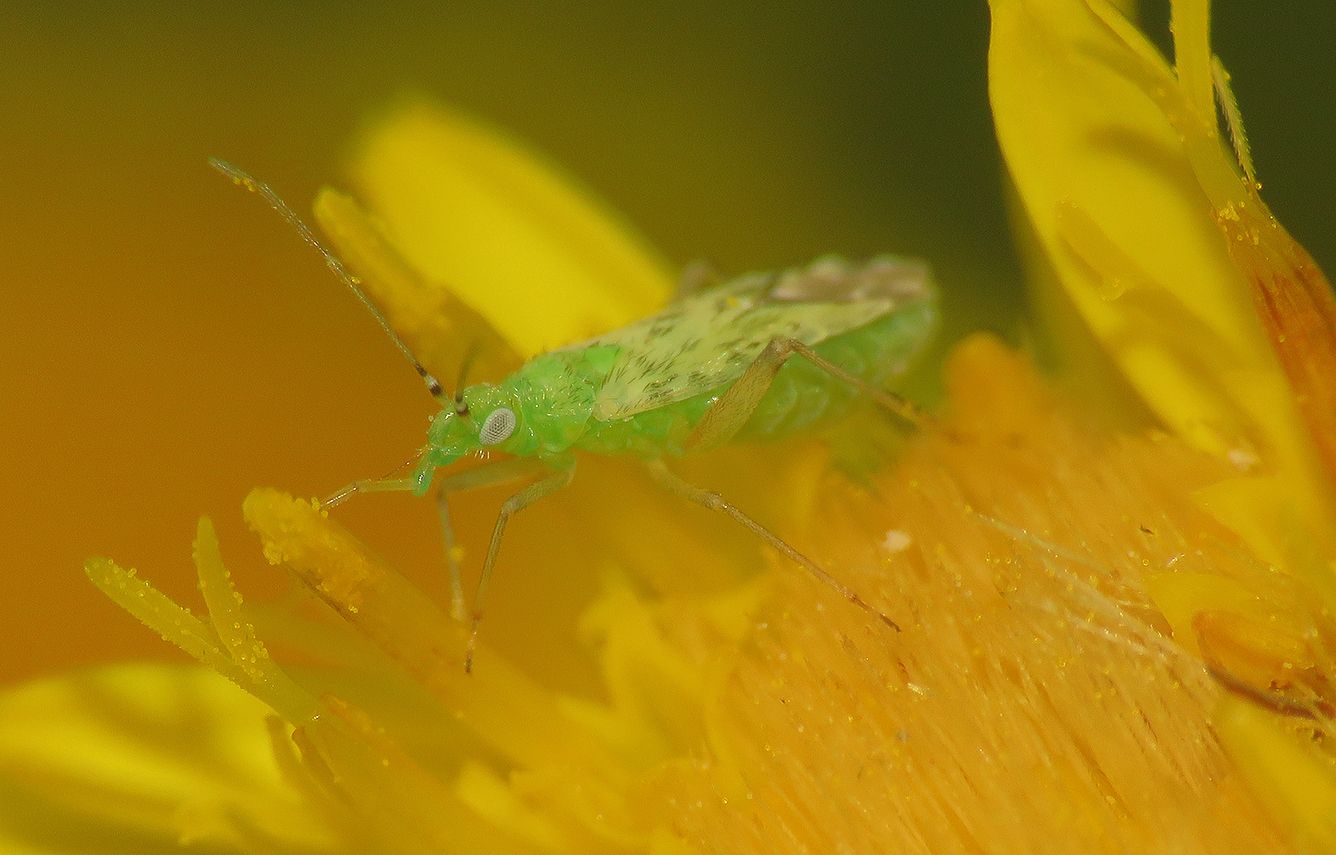 The name of the species is Macrotylus paykulli, and it belongs to the Miridae family. <a href="https://files.peakd.com/file/peakd-hive/borjan/23tvibXxNxbMFL27KVztxZWJQadvevwQh32eGYsYtPbCUCSzBFGHrsWfm5yvXmEXqexta.jpg"><img src="https://files.peakd.com/file/peakd-hive/borjan/23tvibXxNxbMFL27KVztxZWJQadvevwQh32eGYsYtPbCUCSzBFGHrsWfm5yvXmEXqexta.jpg"></a> (Enlargeable) It seems that the tiny bug was piercing the minuscule pollen grains with its proboscis. <a href="https://files.peakd.com/file/peakd-hive/borjan/23tmBh2y5y5pccNFoaWPKQ7PHzNj9US6FQy9JNiDvKEPoRRHwHsLjprFkAdjoVNPe14an.jpg"><img src="https://files.peakd.com/file/peakd-hive/borjan/23tmBh2y5y5pccNFoaWPKQ7PHzNj9US6FQy9JNiDvKEPoRRHwHsLjprFkAdjoVNPe14an.jpg"></a> (Enlargeable) On the ground, less than a meter from Dittrichia viscosa ... <a href="https://files.peakd.com/file/peakd-hive/borjan/Eo6JSrV5XgjsRdxjfpCcrk7s7sKDA4FuykmCyzqiWfzwCiR9XEzjhDoxPYMWMYQ2VNF.jpg"><img src="https://files.peakd.com/file/peakd-hive/borjan/Eo6JSrV5XgjsRdxjfpCcrk7s7sKDA4FuykmCyzqiWfzwCiR9XEzjhDoxPYMWMYQ2VNF.jpg"></a> (Enlargeable) ... I found a well-camouflaged spider. Hogna radiata is a big, robust spider from the Lycosidae family, one of the biggest if not the biggest in this area. Hogna radiata shown in this, the previous, and the next few photographs is a female. 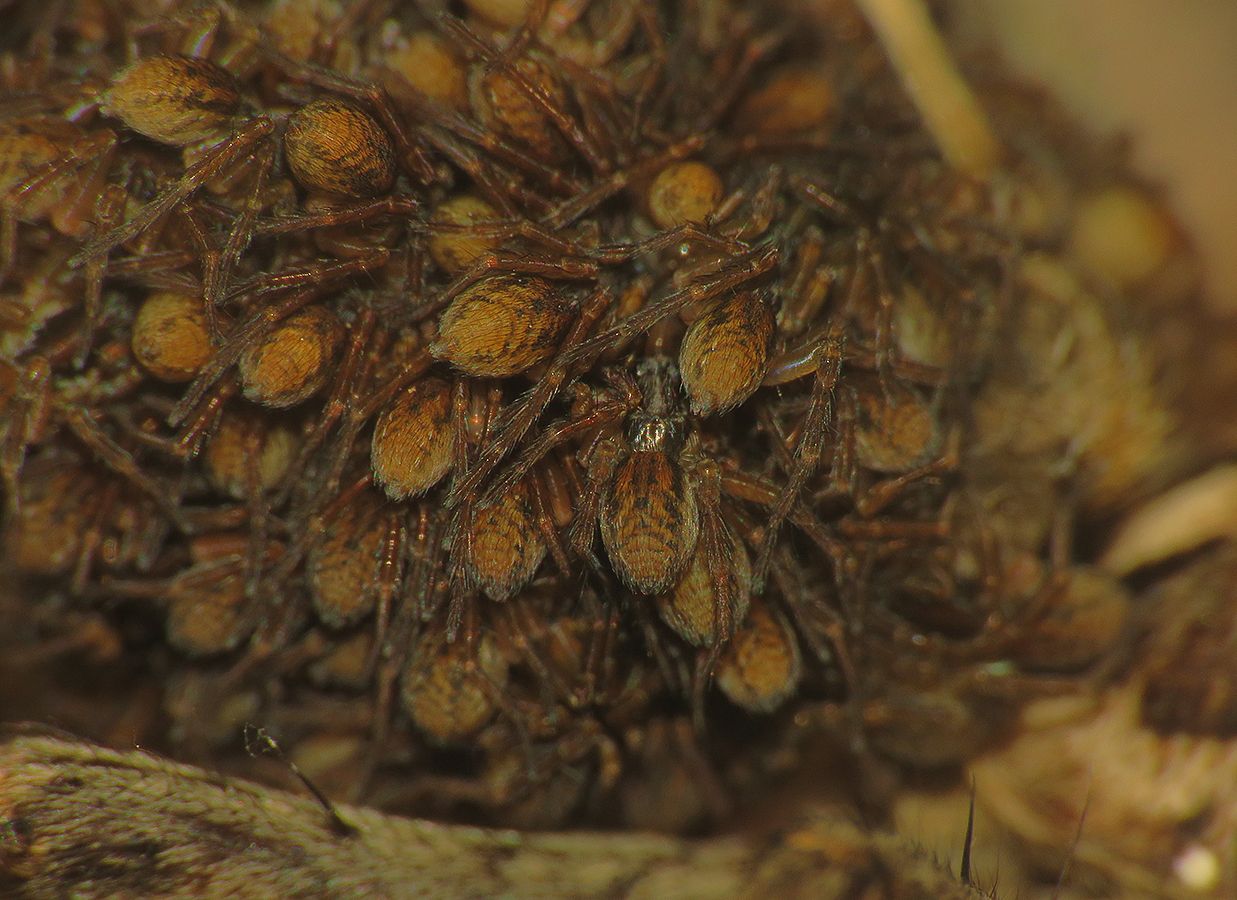 A female with a big cluster of spiderlings on its back. <a href="https://files.peakd.com/file/peakd-hive/borjan/EoAYo2aPKJLR2VRCYM34YMTfnR8FVo8F5RuNrxXP8zPM8omBHKevp7JCKnASzmu46y8.jpg"><img src="https://files.peakd.com/file/peakd-hive/borjan/EoAYo2aPKJLR2VRCYM34YMTfnR8FVo8F5RuNrxXP8zPM8omBHKevp7JCKnASzmu46y8.jpg"></a> (Enlargeable) The tiny juvenile spiders form a compact ball that looks like some kind of brown strawberry from a distance. <a href="https://files.peakd.com/file/peakd-hive/borjan/23tSN1r7JDmrbCxH3YgT2C1NCHJzpLiVbps4vBsXfZSuL5Z7XjHbJZk6RixjLpKrCFgYo.jpg"><img src="https://files.peakd.com/file/peakd-hive/borjan/23tSN1r7JDmrbCxH3YgT2C1NCHJzpLiVbps4vBsXfZSuL5Z7XjHbJZk6RixjLpKrCFgYo.jpg"></a> (Enlargeable) This is nothing new for me, I come across this type of scene at least once or twice a year, in late summer or early autumn, but a big Hogna radiata female transporting its offspring around is always a memorable encounter and a joy to photograph. <a href="https://files.peakd.com/file/peakd-hive/borjan/Enyo4dqtUEL2ENzMDg1wyYrmb8iynGCLBJ2us86Nc7KBjm8dpebkrxr9FyppsBU3DnK.jpg"><img src="https://files.peakd.com/file/peakd-hive/borjan/Enyo4dqtUEL2ENzMDg1wyYrmb8iynGCLBJ2us86Nc7KBjm8dpebkrxr9FyppsBU3DnK.jpg"></a> (Enlargeable) Five or then minutes later, always of the same Dittrichia viscosa plant ... 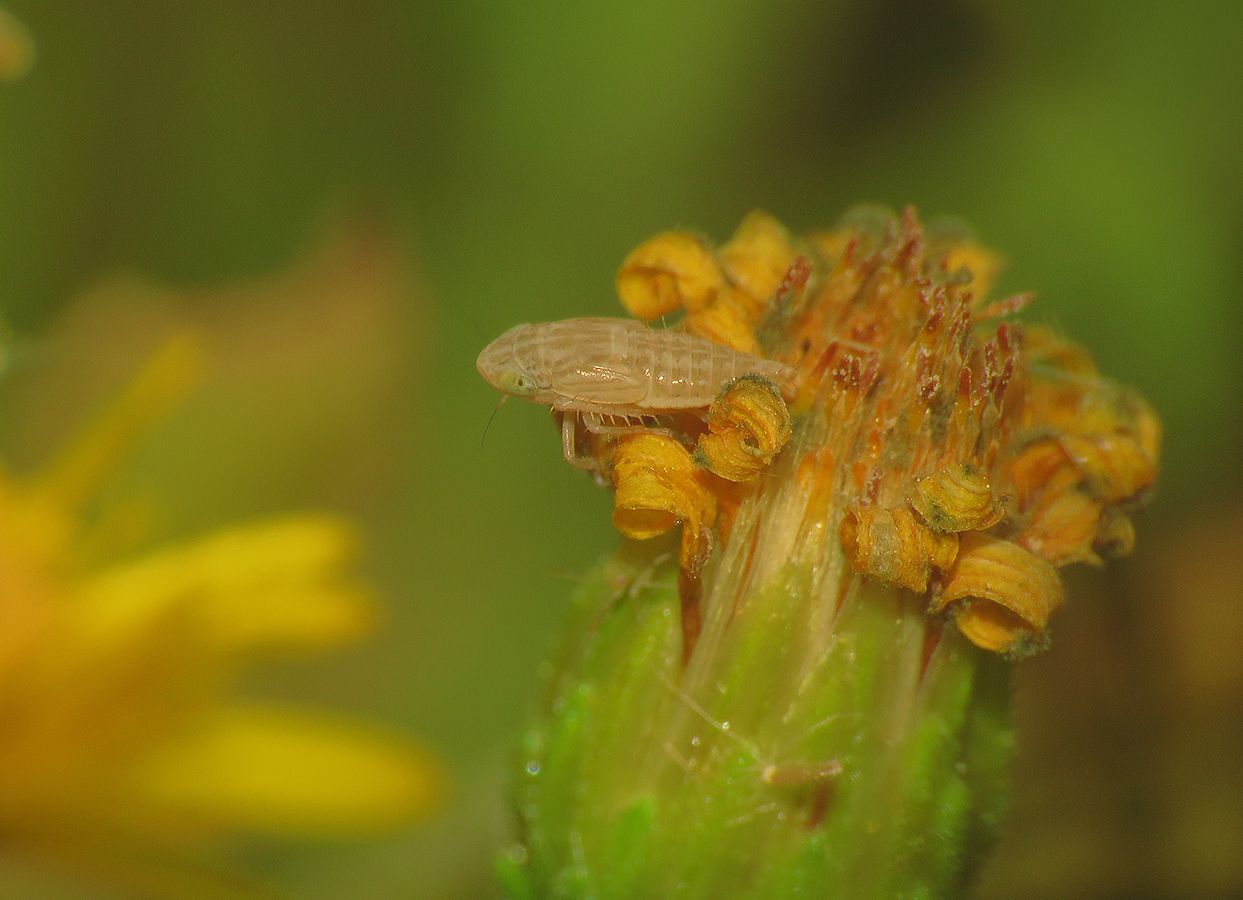 ... I photographed this leafhopper nymph. 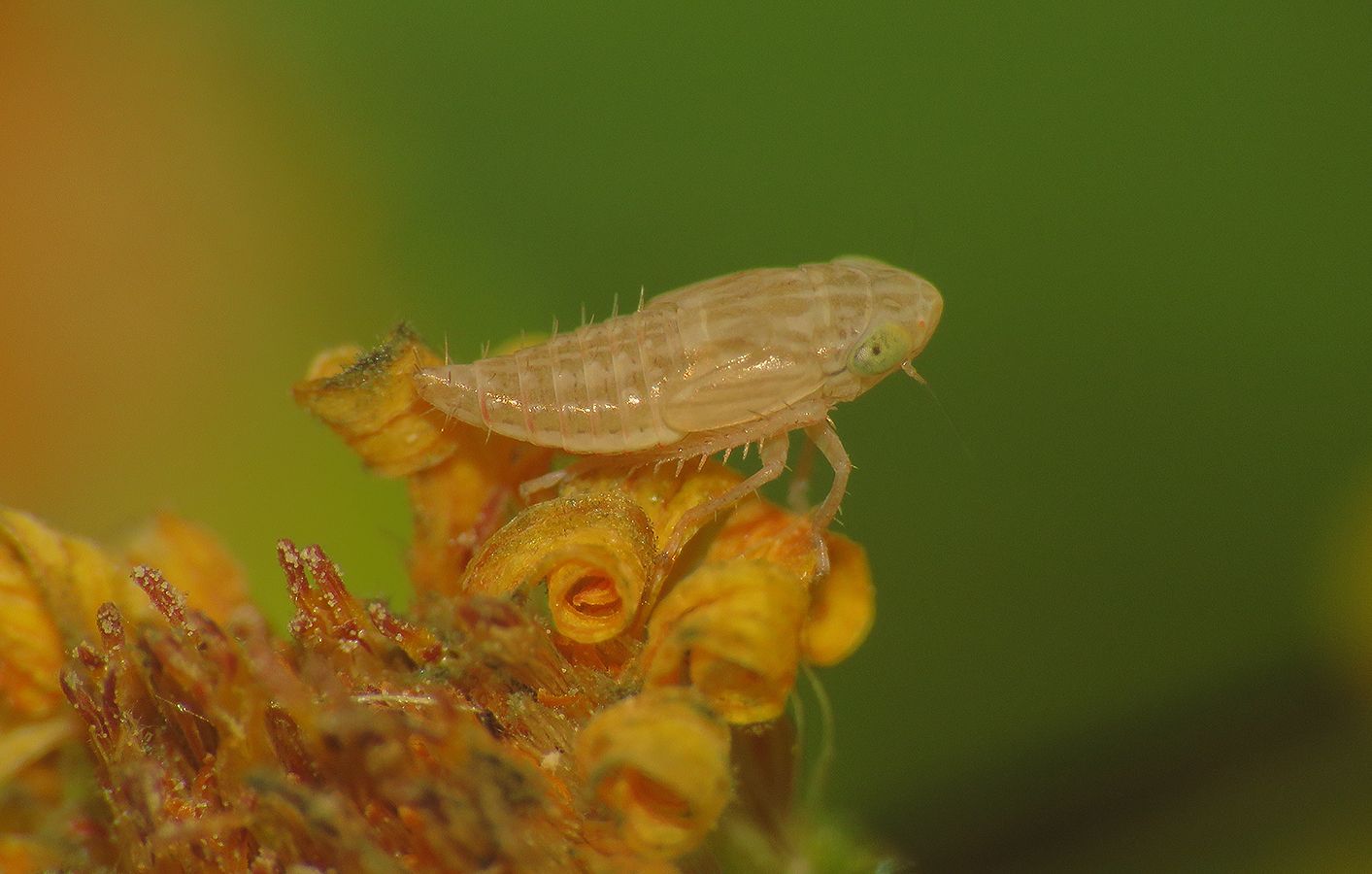 In this case, I can't tell you the name of the species. The family is Cicadellidae, of course. <a href="https://files.peakd.com/file/peakd-hive/borjan/23tbPiZF9AwhaeMmsapybu8EmdTKJ5yb5SThtbv3cF4jgcB6PWCDmiDEoCoq1xYC1hjXc.jpg"><img src="https://files.peakd.com/file/peakd-hive/borjan/23tbPiZF9AwhaeMmsapybu8EmdTKJ5yb5SThtbv3cF4jgcB6PWCDmiDEoCoq1xYC1hjXc.jpg"></a> (Enlargeable) This is the Colias croceus, a butterfly from the Pieridae family. <a href="https://files.peakd.com/file/peakd-hive/borjan/EoEjGyATLC4B5vbfHpvfhWgjtPi9baGockg6NAHGmKq1tmcDTSj3mijC3dxKM3EbwrX.jpg"><img src="https://files.peakd.com/file/peakd-hive/borjan/EoEjGyATLC4B5vbfHpvfhWgjtPi9baGockg6NAHGmKq1tmcDTSj3mijC3dxKM3EbwrX.jpg"></a> (Enlargeable) The butterfly was found and photographed on one of the young Dittrichia viscosa plants that still haven't produced tall stems with many flowers. <a href="https://files.peakd.com/file/peakd-hive/borjan/23tkozyYKkPxRtF8mZuPGvzXdtsdEJBGzcFMvgcisgLwEpXiZ9WV1jXh796bmyqHnEgys.jpg"><img src="https://files.peakd.com/file/peakd-hive/borjan/23tkozyYKkPxRtF8mZuPGvzXdtsdEJBGzcFMvgcisgLwEpXiZ9WV1jXh796bmyqHnEgys.jpg"></a> (Enlargeable) I photographed the same butterfly in two different ways. Once with the flash of my camera on, and then, using a longer exposure, in the subdued ambient light at the end of that warm October day. 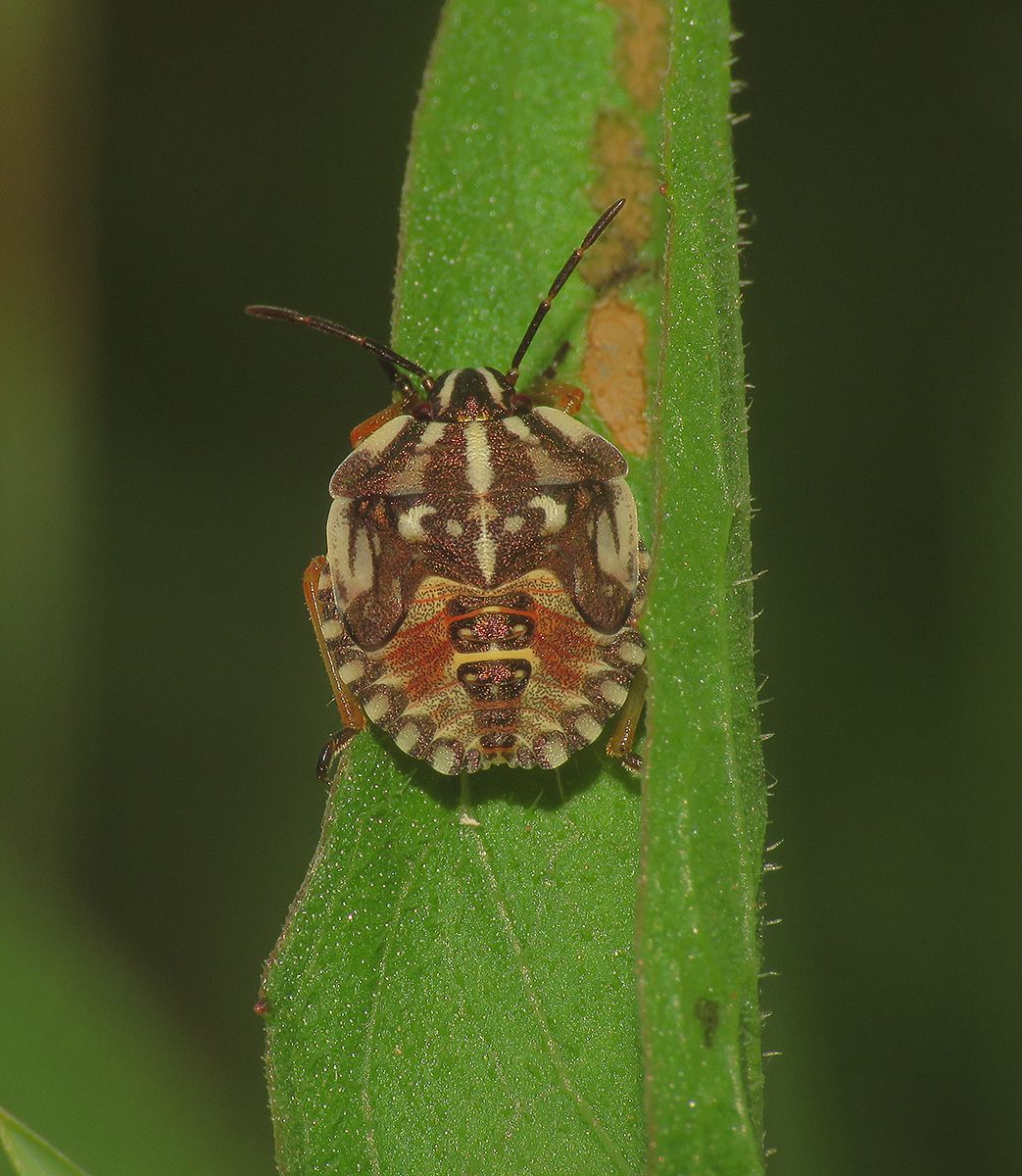 On the leaves of another herbaceous plant a couple of meters further ... <a href="https://files.peakd.com/file/peakd-hive/borjan/EoJz6Th14HcPRg9YydsVKyYW3bCXDqPtpxsmi728yG9EYMkFWkaBBZu9d938NSJ6u3w.jpg"><img src="https://files.peakd.com/file/peakd-hive/borjan/EoJz6Th14HcPRg9YydsVKyYW3bCXDqPtpxsmi728yG9EYMkFWkaBBZu9d938NSJ6u3w.jpg"></a> (Enlargeable) ... I found a small group of Carpocoris purpureipennis nymphs. 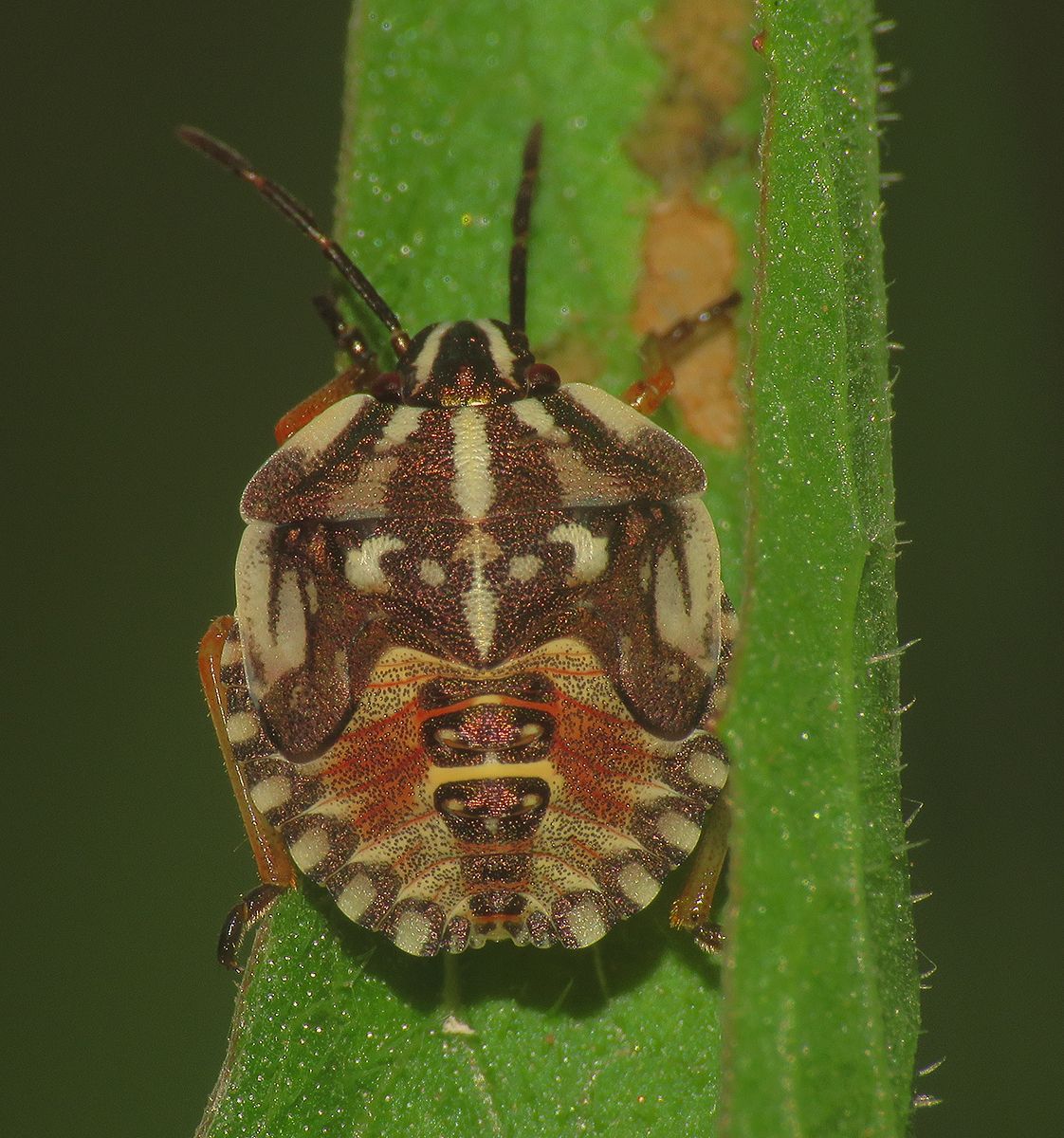 The Carpocoris purpureipennis shown in this and the previous two photographs are the 5th instar nymphs ready to become adults soon. <a href="https://files.peakd.com/file/peakd-hive/borjan/Eo8LUgpwfW56mrbAak5cLyrf77Sw9y3L2qkWH5CYcfSuz5EwyssAJJ5bNvLMTMNHoAH.jpg"><img src="https://files.peakd.com/file/peakd-hive/borjan/Eo8LUgpwfW56mrbAak5cLyrf77Sw9y3L2qkWH5CYcfSuz5EwyssAJJ5bNvLMTMNHoAH.jpg"></a> (Enlargeable) This one is a bit younger - a 4th instar nymph. Not far from these nymphs, less than a meter, I think ... <a href="https://files.peakd.com/file/peakd-hive/borjan/23tbkyaHbZHvBGM5Rmp1CLwxE7m8XrU27MmZAtBRyGejNicS4SF1eT8BbFcEbAhcKpWB9.jpg"><img src="https://files.peakd.com/file/peakd-hive/borjan/23tbkyaHbZHvBGM5Rmp1CLwxE7m8XrU27MmZAtBRyGejNicS4SF1eT8BbFcEbAhcKpWB9.jpg"></a> (Enlargeable) ... I photographed this Emmelina monodactyla, a moth from the Pterophoridae family. <a href="https://files.peakd.com/file/peakd-hive/borjan/Eo1wMUbv7siuaPdrHUcm6T2W6RsMTjodwBKvMeQkH2dL6SekGYRySZuikZscXgDnfy9.jpg"><img src="https://files.peakd.com/file/peakd-hive/borjan/Eo1wMUbv7siuaPdrHUcm6T2W6RsMTjodwBKvMeQkH2dL6SekGYRySZuikZscXgDnfy9.jpg"></a> (Enlargeable) Here you can take another quick break from the macro view. The photograph shows the vegetation by the side of one of the narrow unpaved roads that lead through Marlera. You can see ferns, flowers, blackberry shrubs, and more. <a href="https://files.peakd.com/file/peakd-hive/borjan/23tm9BVaYcthTKBvbDXHF99VEwqxeAZMouZgj4zNxHXuXGQoH4JiwFieDgzNe88ch79ee.jpg"><img src="https://files.peakd.com/file/peakd-hive/borjan/23tm9BVaYcthTKBvbDXHF99VEwqxeAZMouZgj4zNxHXuXGQoH4JiwFieDgzNe88ch79ee.jpg"></a> (Enlargeable) On the Foeniculum vulgare plant, I photographed a Papilio machaon caterpillar. <a href="https://files.peakd.com/file/peakd-hive/borjan/23tbRcWMmbVLkMqsQQY9qgoDV8aLoDVcLfMh2Fqnxc5bj2JWxNHunX4EpE2euRcnwbjqB.jpg"><img src="https://files.peakd.com/file/peakd-hive/borjan/23tbRcWMmbVLkMqsQQY9qgoDV8aLoDVcLfMh2Fqnxc5bj2JWxNHunX4EpE2euRcnwbjqB.jpg"></a> (Enlargeable) Judging by its pose and overall look, this caterpillar is dead. <a href="https://files.peakd.com/file/peakd-hive/borjan/23t79Ku433pu2kAXc2wCsAkpcjAZEXx78XyaNjSjQLYtZFCrmoYHPrAfZo4ybqwpbaY8X.jpg"><img src="https://files.peakd.com/file/peakd-hive/borjan/23t79Ku433pu2kAXc2wCsAkpcjAZEXx78XyaNjSjQLYtZFCrmoYHPrAfZo4ybqwpbaY8X.jpg"></a> (Enlargeable) In this set of four wide shots, you can see the tall dry grass that resembles a series of abstract, accidental scribbles. On one of these dry stems, a few minutes after the sunset ... <a href="https://files.peakd.com/file/peakd-hive/borjan/23tGVuseBftcdz1vh3FYPfVtYtEVh6bgMYYC7CuNajULRjzYS2ZLhjiCtZkw972MKVduZ.jpg"><img src="https://files.peakd.com/file/peakd-hive/borjan/23tGVuseBftcdz1vh3FYPfVtYtEVh6bgMYYC7CuNajULRjzYS2ZLhjiCtZkw972MKVduZ.jpg"></a> (Enlargeable) ... I photographed this wasp that was getting ready to overnight on the top of the grass. <a href="https://files.peakd.com/file/peakd-hive/borjan/23tGY4iHCesbeNWF174C1AaWnB7yiemHHcHRV2PCHekLZkvYHX65Huvp3Vjq1uy8AJSYP.jpg"><img src="https://files.peakd.com/file/peakd-hive/borjan/23tGY4iHCesbeNWF174C1AaWnB7yiemHHcHRV2PCHekLZkvYHX65Huvp3Vjq1uy8AJSYP.jpg"></a> (Enlargeable) Can't tell you the name of the species, but I'm sure that it's a potter wasp from the subfamily Eumeninae in the large and varied Vespidae family. <a href="https://files.peakd.com/file/peakd-hive/borjan/23tbppLcpEB7A1ggXktkwE31xvLzkE8VrGnLVfPN65bMB7QC3fsWqARbF5H34jvuAESRT.jpg"><img src="https://files.peakd.com/file/peakd-hive/borjan/23tbppLcpEB7A1ggXktkwE31xvLzkE8VrGnLVfPN65bMB7QC3fsWqARbF5H34jvuAESRT.jpg"></a> (Enlargeable) This moth was found and photographed on the short green grass close to the ground. Nomophila noctuella is the name of this species from the Crambidae family. <a href="https://files.peakd.com/file/peakd-hive/borjan/EoAZEUTZ6rJKLYnQqYFpvqFGtk9dKxywxqJyFrRf6hBQTSgpYYWN6LadxG7WX2WhkMX.jpg"><img src="https://files.peakd.com/file/peakd-hive/borjan/EoAZEUTZ6rJKLYnQqYFpvqFGtk9dKxywxqJyFrRf6hBQTSgpYYWN6LadxG7WX2WhkMX.jpg"></a> (Enlargeable) In the same area covered with tall dry grass and green grass mixed with various herbaceous plants underneath it, I also found one bushcricket and one grasshopper. I'll show you the bushcricket first. <a href="https://files.peakd.com/file/peakd-hive/borjan/Eo8RNq3gMq8hzYibRDvuP2Ufte3PFoffnjhNP5QREgGwnTSJVbar6Xa9891UGEUNTZa.jpg"><img src="https://files.peakd.com/file/peakd-hive/borjan/Eo8RNq3gMq8hzYibRDvuP2Ufte3PFoffnjhNP5QREgGwnTSJVbar6Xa9891UGEUNTZa.jpg"></a> (Enlargeable) In this, the previous, and the following shot ... <a href="https://files.peakd.com/file/peakd-hive/borjan/23tGyLvLSAnaR9QTSxq4E2CNaEp5zNEFXm6itS91pizAv5WZz2QzCFoE1Js8WAk3ccszW.jpg"><img src="https://files.peakd.com/file/peakd-hive/borjan/23tGyLvLSAnaR9QTSxq4E2CNaEp5zNEFXm6itS91pizAv5WZz2QzCFoE1Js8WAk3ccszW.jpg"></a> (Enlargeable) ... you can see the Rhacocleis germanica bushcricket. <a href="https://files.peakd.com/file/peakd-hive/borjan/23u62sLY1ciyd14hBnzeoJMk4E27oGJcC34khTvoFGDr3e54StHNcG4KSprmhFLLdGjA7.jpg"><img src="https://files.peakd.com/file/peakd-hive/borjan/23u62sLY1ciyd14hBnzeoJMk4E27oGJcC34khTvoFGDr3e54StHNcG4KSprmhFLLdGjA7.jpg"></a> (Enlargeable) This is the grasshopper. <a href="https://files.peakd.com/file/peakd-hive/borjan/23tmFdWBvPXeWFZ8nC3bHwDJPBMrM6uge2yfSV1Phapn1SeA28Vkbp2TjbgssPnGTaxmP.jpg"><img src="https://files.peakd.com/file/peakd-hive/borjan/23tmFdWBvPXeWFZ8nC3bHwDJPBMrM6uge2yfSV1Phapn1SeA28Vkbp2TjbgssPnGTaxmP.jpg"></a> (Enlargeable) A well-camouflaged Chorthippus brunneus grasshopper. <a href="https://files.peakd.com/file/peakd-hive/borjan/23uQp4ScGyshaHvgWFp1uUCrUjQBNjs8eak8rn9yFyucPZJrZ4hBvheQBYQXM3h6jXsyC.jpg"><img src="https://files.peakd.com/file/peakd-hive/borjan/23uQp4ScGyshaHvgWFp1uUCrUjQBNjs8eak8rn9yFyucPZJrZ4hBvheQBYQXM3h6jXsyC.jpg"></a> (Enlargeable) The small red detail on the grasshopper's abdomen is the only part of its body that sticks out from the rest. <a href="https://files.peakd.com/file/peakd-hive/borjan/EoJxfZXG2UcEqYFUJJLyjfcFDTGtywVVhazgiWJeV4E3G6m9bcPrHUyBzKN8prz9jWC.jpg"><img src="https://files.peakd.com/file/peakd-hive/borjan/EoJxfZXG2UcEqYFUJJLyjfcFDTGtywVVhazgiWJeV4E3G6m9bcPrHUyBzKN8prz9jWC.jpg"></a> (Enlargeable) I photographed one more scene on the large Dittrichia viscosa plant covered with many flowers in various stages of development. 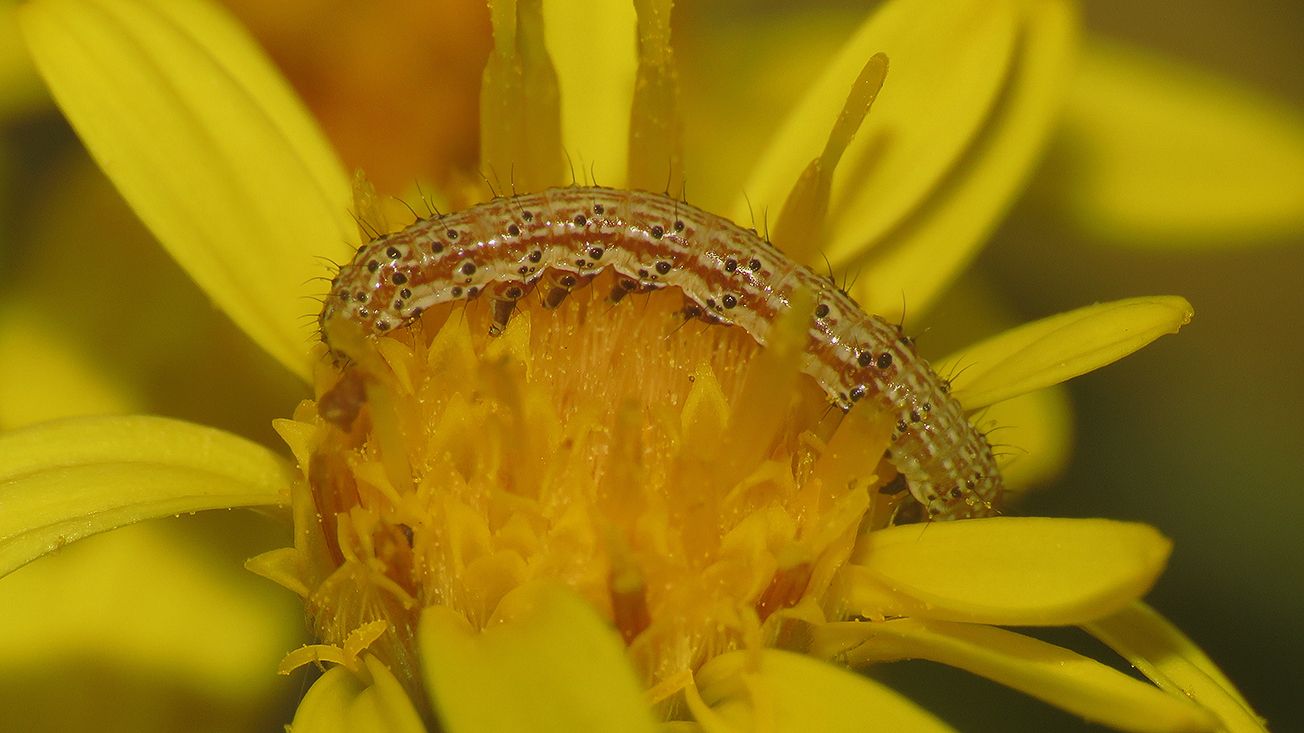 Here you can see the Helicoverpa armigera caterpillar that was feeding on one of the still fresh flowers with plenty of pollen and nectar. Helicoverpa armigera is a moth from the Noctuidae family. 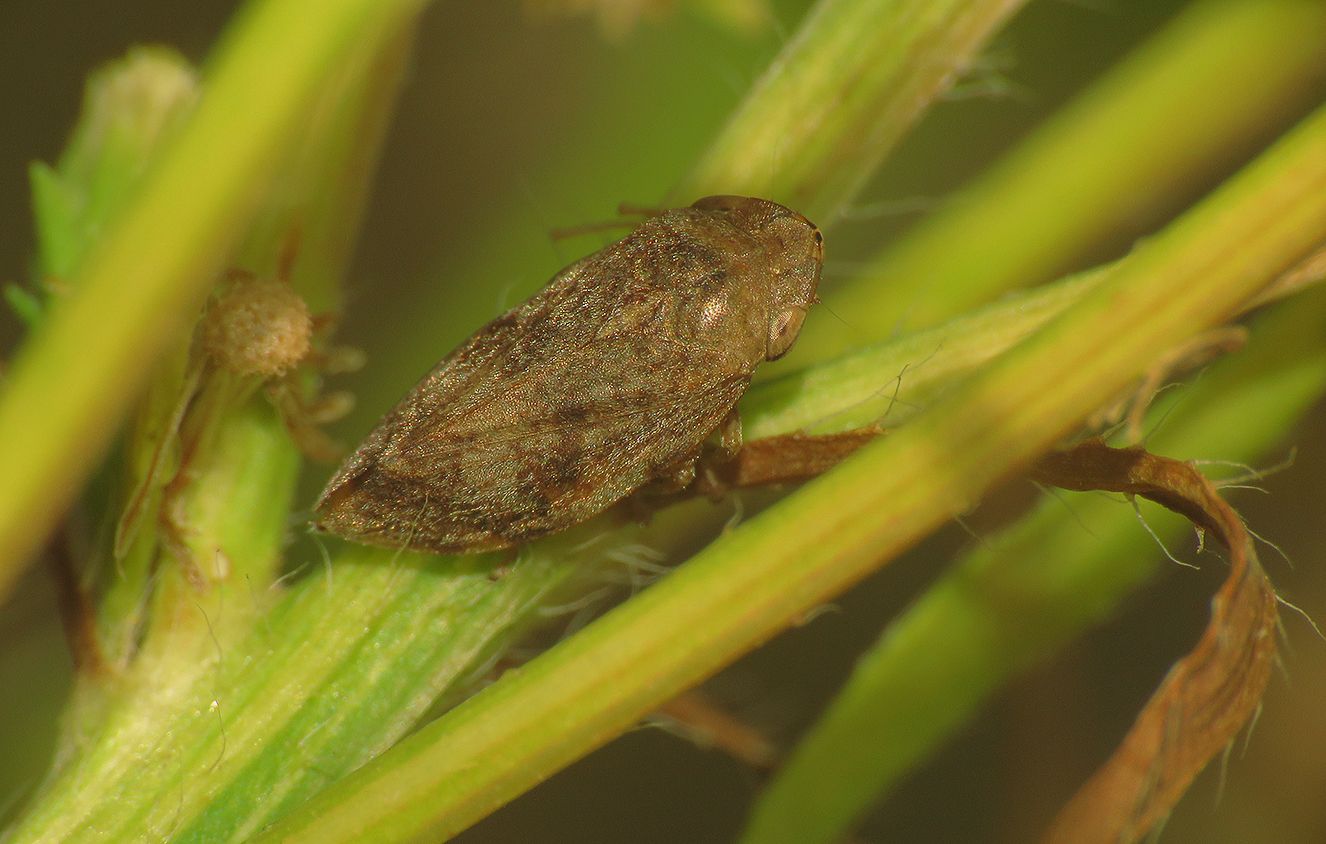 This froghopper from the Aphrophoridae family was resting on the Erigeron bonariensis plant. The name of the species is Aphrophora alni. 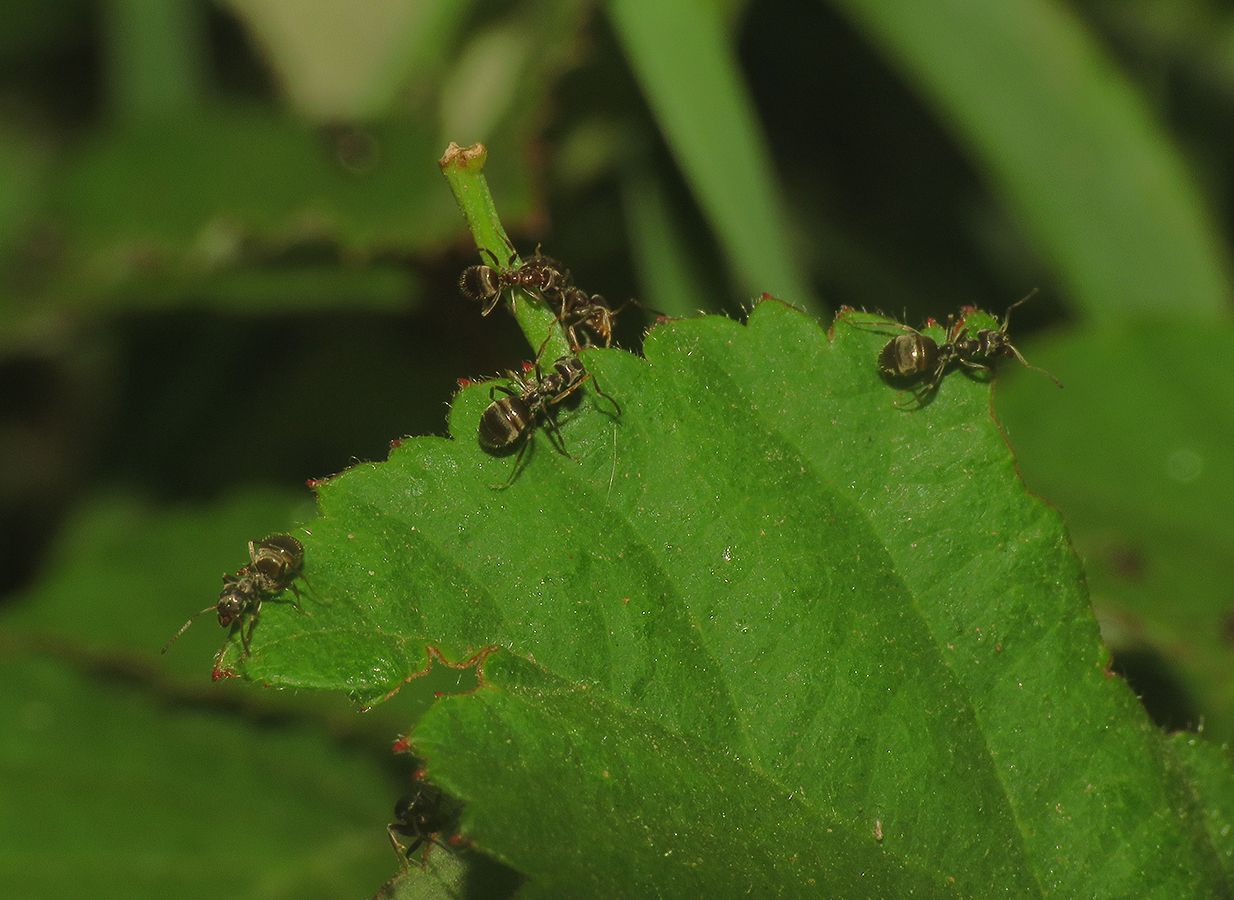 Here you can see a small group of Lasius niger ants running across the leaf of the blackberry shrub. In the following photograph ... 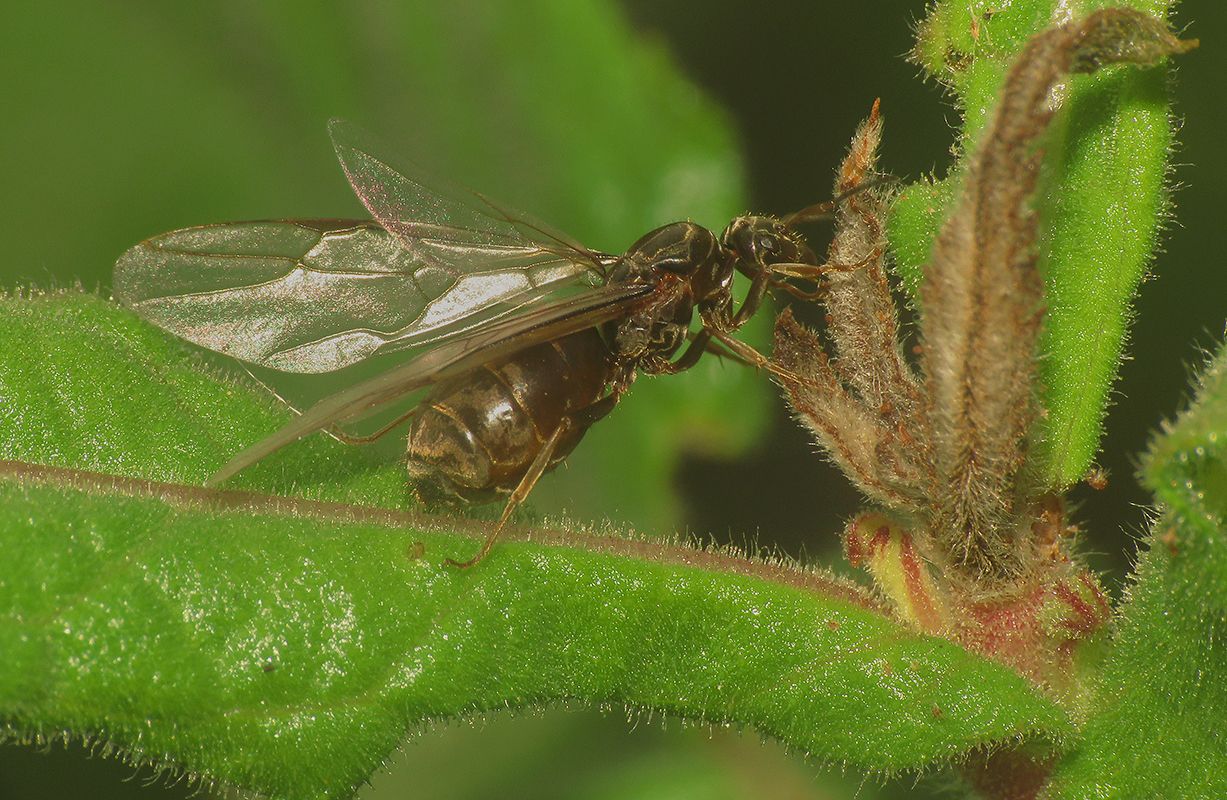 ... you can see the much bigger winged queen of the same species climbing the nearby Dittrichia viscosa. <a href="https://files.peakd.com/file/peakd-hive/borjan/23t7AyUmhioCvktKUFjAKdMDU6WZRRqhEmKBxCbNSHmwrov4o3QmQneHKt9VZHfrAZwYL.jpg"><img src="https://files.peakd.com/file/peakd-hive/borjan/23t7AyUmhioCvktKUFjAKdMDU6WZRRqhEmKBxCbNSHmwrov4o3QmQneHKt9VZHfrAZwYL.jpg"></a> (Enlargeable) Here you can see the same queen on one of the leaves on the top of the plant. 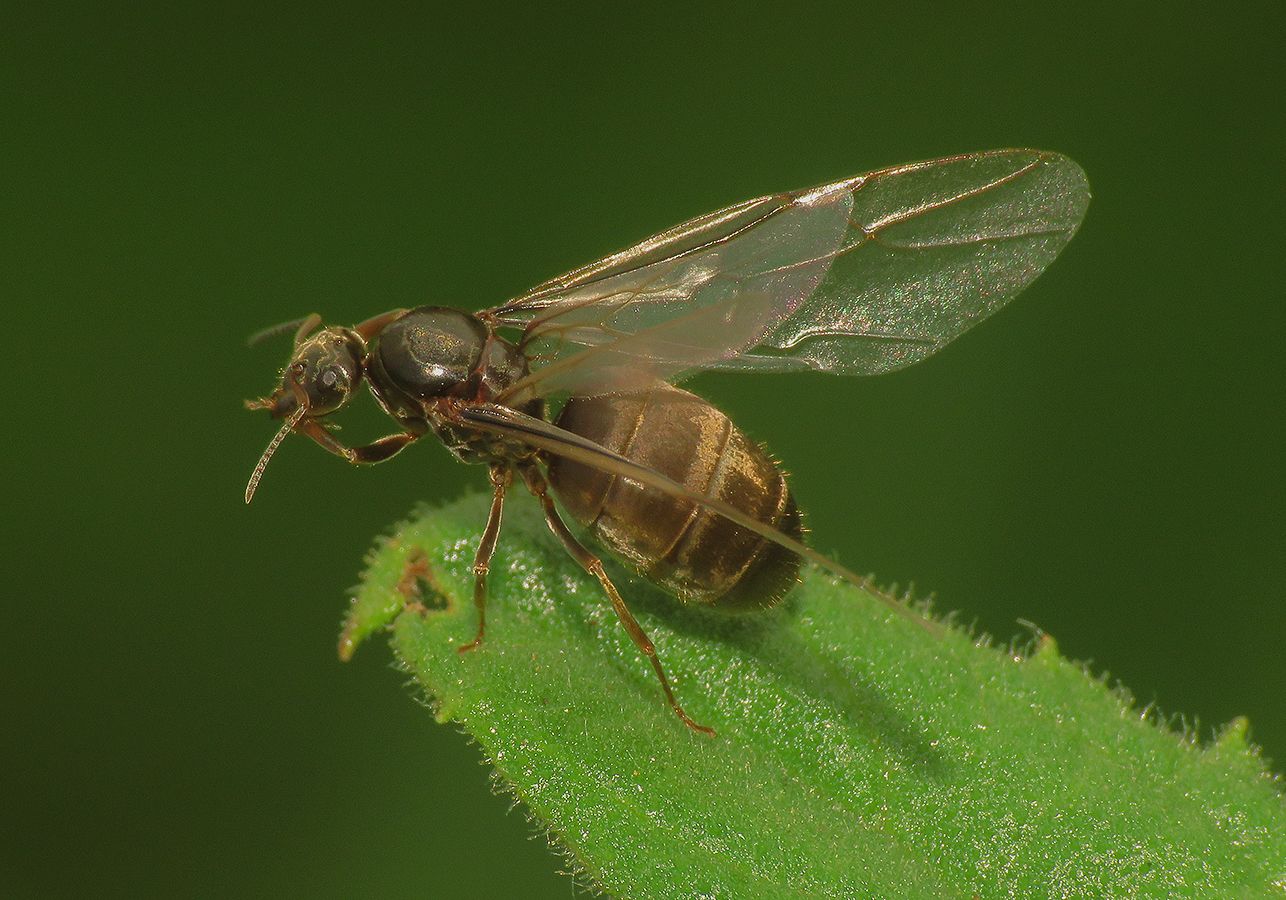 The night was very near. The light was pretty low. So at first, I photographed the ant with the flash of my camera on ... <a href="https://files.peakd.com/file/peakd-hive/borjan/23t7BZbz8gVNEWcSm92R81efdfSjVVwsUFEq5SRWtHqRJxHYerkvWDteeiKFKjqk2pSnv.jpg"><img src="https://files.peakd.com/file/peakd-hive/borjan/23t7BZbz8gVNEWcSm92R81efdfSjVVwsUFEq5SRWtHqRJxHYerkvWDteeiKFKjqk2pSnv.jpg"></a> (Enlargeable) ... but the scene looked much better in the subdued ambient light. It took me some time and a lot of patience to get these shots that show the queen's wings in all their elegant beauty. The wings are there only to take the reproductive ant further from the colony in which was originated. That further could be ten or twenty meters, but it could also be fifty meters or more, hundreds of meters sometimes. <a href="https://files.peakd.com/file/peakd-hive/borjan/23tGZrm1AyCF4XmqsJTZw3bEx1oB2arNX8uPNQVG6ZTDiEcNEW9DPC3sSrScALeWnrcqL.jpg"><img src="https://files.peakd.com/file/peakd-hive/borjan/23tGZrm1AyCF4XmqsJTZw3bEx1oB2arNX8uPNQVG6ZTDiEcNEW9DPC3sSrScALeWnrcqL.jpg"></a> (Enlargeable) After the mating the males die and females shed their beautiful wings. 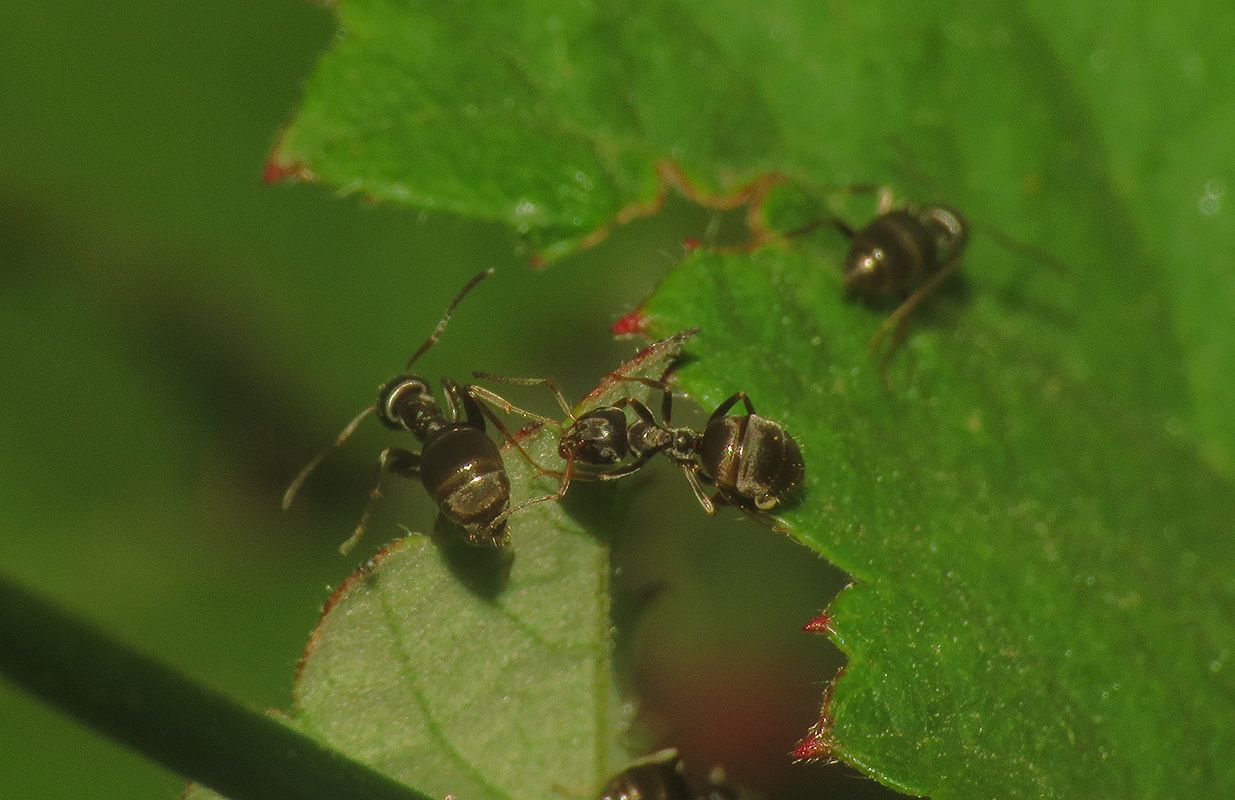 The workers are very busy and frenetic when the winged kings and queens get released to spread like seeds that will establish new colonies. ## AND THAT'S IT. AS ALWAYS HERE ON HIVE, THE PHOTOGRAPHS ARE MY WORK - THE END. The following links will take you to the sites with more information about some of the protagonists of this post. I found some stuff about them there. https://en.wikipedia.org/wiki/Carpocoris_purpureipennis https://en.wikipedia.org/wiki/Dittrichia_viscosa https://www.britishbugs.org.uk/heteroptera/Miridae/Macrotylus_paykulli.html https://en.wikipedia.org/wiki/Hogna_radiata https://en.wikipedia.org/wiki/Colias_croceus https://en.wikipedia.org/wiki/Emmelina_monodactyla https://en.wikipedia.org/wiki/Potter_wasp https://en.wikipedia.org/wiki/Nomophila_noctuella https://uk.inaturalist.org/taxa/503132-Rhacocleis-germanica https://en.wikipedia.org/wiki/Chorthippus_brunneus https://en.wikipedia.org/wiki/Aphrophora_alni https://www.antwiki.org/wiki/Lasius_niger
👍 kawsar8035, ma3str0, theissen, prydefoltz, liaminit1, an-man, cliffagreen, dishant018, teamvn, smartvote, canadian.man, hive-166168, uncorked-reality, wannatrailwithme, azymiy-photo, hoosie, gunnarheilmann, portal-xenna, elchaleefatoe15, johannpiber, knfitaly, syawalularsya, belkisa758, onlavu, smasssh, partitura.ccc, marlyncabrera, sharpshot, alexis555, pixelfan, eturnerx-dbuzz, msp-foundation, lingkar-photo, cornerstone, itinerantph, we-are-palcoin, digital-fortress, curatorcat.pal, fun.farms, alchemystones, svanbo, ninahaskin, cervisia, jlufer, steemitbloggers, nickydee, eliza.anne, unmuted, dannewton, earthsea, andylein, jlinaresp, mathowl, omstavan, jd4e, mechanicalowl, regularowl, discovery-it, marcolino76, phage93, titti, victoriaxl, thinkcoin, jilt, krrizjos18, farmingtales, yzamazing, vittoriozuccala, juanbg, spiceboyz, gianluccio, ciuoto, alequandro, pab.ink, piumadoro, mad-runner, sbarandelli, spaghettiscience, nattybongo, gordonramzy, middleearth, lallo, stregamorgana, maruskina, omodei, damaskinus, discovery-blog, pecoshop, boomalex, matteus57, maridmc, pinkchic, armandosodano, adinapoli, samuel.steem, paolo.senegal, meeplecomposer, capitanonema, btc4breackfast, bindalove, robertonis, jlsplatts, littlebee4, kharrazi, simgirl, deirdyweirdy, lxsxl, bereal47, txatxy, friendmoose.pob, anacristinasilva, agmoore, petrvl, belahejna, maajaanaa, slunicko, kcgm, krakatice, stayoutoftherz, enforcer48, steemseph, adamada, calatorulmiop, jazzhero, sgbonus, avatara, strega.azure, leaky20, oldmans, kevmcc, ekavieka, emma-h, olympicdragon, qwerrie, caleb-marvel, unlockmaster, lolz.photo, photo-curator, catsndogs, marpa, emma-h2, jasuly, jaki01, bodrex27, theoctoberwind, daveks, artonmysleeve, lapasta, tarotbyfergus, amiegeoffrey, b-hive, mnurhiver, holovision.stem, insaneworks, fermentedphil, kaminchan, birdwatcher, junaidfazal, sifondeseltz, wanker, rafzat, soulsdetour, lee1938, sbi8, dsc-r2cornell, deimage, hattaarshavin, rynow, blewitt, teamashen, akukamaruzzaman, visualshots, maryjacy, dimascastillo90, josueand, sassy.cebuana, rop1, visualbot, laimagenhabla, vielsiarias, dicmerrivas, aliciarodriguez, sagarkothari88, samuraiscam, xerox94, iskawrites, hivebuzz, lizanomadsoul, manncpt, jnmarteau, crypticat, nikv, steemitboard, marivic10, fantagira, marsupia, ahlawat, goldenoakfarm, riki1, yulia-hive, nicolelorena, awuahbenjamin, nurul-uli, mattsanthonyit, valorbeats, abukareung01, lemouth, steemstem-trig, steemstem, minnowbooster, howo, aboutcoolscience, robotics101, roelandp, dna-replication, stemsocial, curie, edb, valth, sustainablyyours, samminator, madridbg, fragmentarion, flugschwein, melvin7, gadrian, temitayo-pelumi, pboulet, stem.witness, sam9999, abu78, metabs, privex, dhimmel, alexander.alexis, abigail-dantes, emiliomoron, geopolis, francostem, crowdwitness, prosocialise, lamouthe, walterjay, mobbs, tsoldovieri, enzor, postpromoter, r00sj3, intrepidphotos, de-stem, deholt, zeruxanime, noelyss, greengalletti, techslut, dandesign86, zonguin, aidefr, kenadis, sco, alexdory, jjerryhan, kqaosphreak, croctopus, thelittlebank, cryptofiloz, bilpcoinbpc, yixn, cubapl, bartosz546, doctor-cog-diss, baltai, vscampbell, therising, beckyonweb, tfeldman, princessmewmew, mayorkeys, metroair, zyx066, jasedmf, rocky1, cnfund, pandasquad, anttn, apokruphos, sarashew, justyy, dimarss, thelordsharvest, steemcryptosicko, pandapuzzles, enjar, neneandy, nateaguila, gunthertopp, investingpennies, braaiboy, bflanagin, marc-allaria, doifeellucky, communitybank, utube, sportscontest, fantasycrypto, photohunt, superlotto, cakemonster, steemstorage, neumannsalva, steemean, aabcent, onewolfe, dynamicrypto, irgendwo, greddyforce, jmsansan, detlev, rt395, achimmertens, bscrypto, sumant, quinnertronics, mayberlys, fineartnow, felt.buzz, mugueto2022, reverio, federacion45, putu300, kylealex, the420syndicate, tobias-g, aries90, iansart, meritocracy, dcrops, traderhive, seinkalar, sbtofficial, crypt0gnome, precarious, bitrocker2020, brotherhood, hetty-rowan, windail1, movingman, dodovietnam, lorenzopistolesi, dreamm, punchline, minerthreat, empath, brianoflondon, steemwizards, revo, steveconnor, drricksanchez, fotogruppemunich, apshamilton, hamismsf, jpbliberty, podping, kevinwong, netaterra, takowi, rhemagames, thecryptodrive, modernzorker, cheese4ead, sunsea, spirit09, meno, holoferncro, mayllerlys, tanzil2024, cloh76, carn, goblinknackers, qberry, rmach, mcsvi, ibt-survival, sanderjansenart, mafufuma, reggaesteem, holovision.cash, pladozero, atheistrepublic, lightpaintershub, cryptictruth, jerrybanfield, lordvader, juecoree, stem-espanol, lorenzor, azulear, sandracarrascal, ydavgonzalez, miguelangel2801, tomastonyperez, elvigia, josedelacruz, erickyoussif, andrick, uche-nna, fran.frey, iamphysical, acont, giulyfarci52, psicoluigi, walterprofe, buttcoins, dandays, vaultec, nfttunz, eric-boucher, robertbira, esthersanchez, ajfernandez, orlandogonzalez, cyprianj, ennyta, endopediatria, bluefinstudios, mysteriousroad, gamersclassified, misshugo,